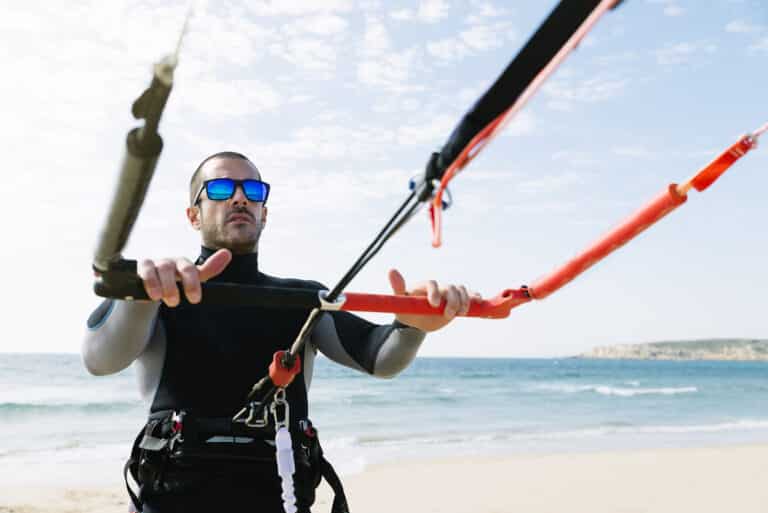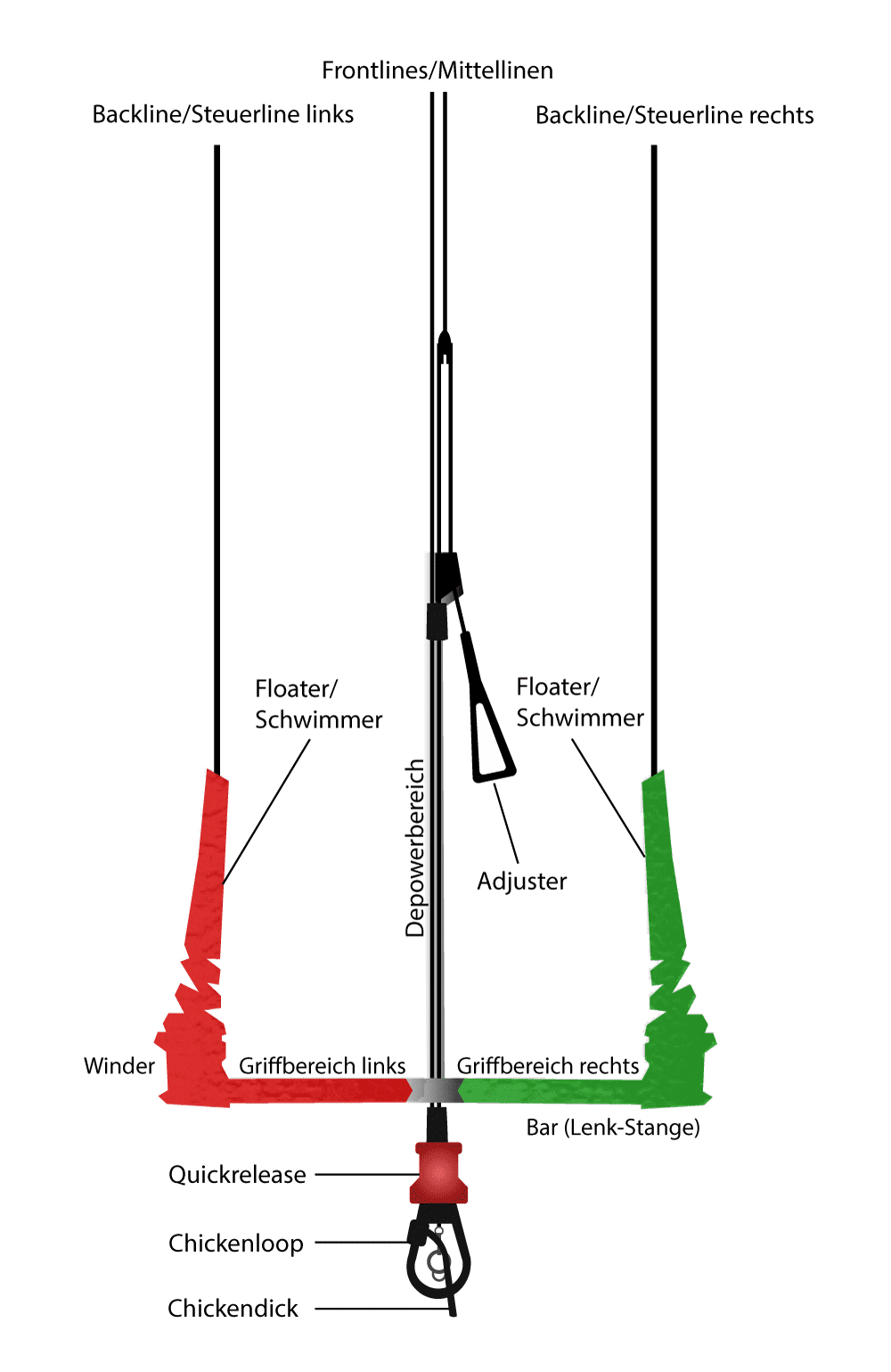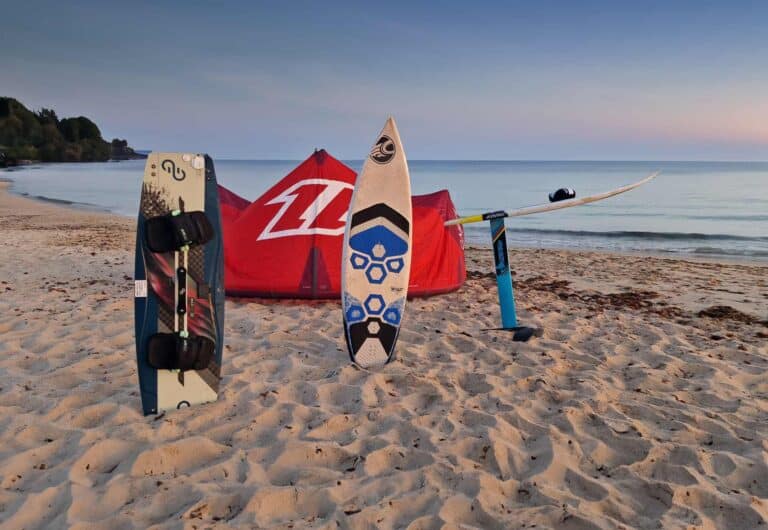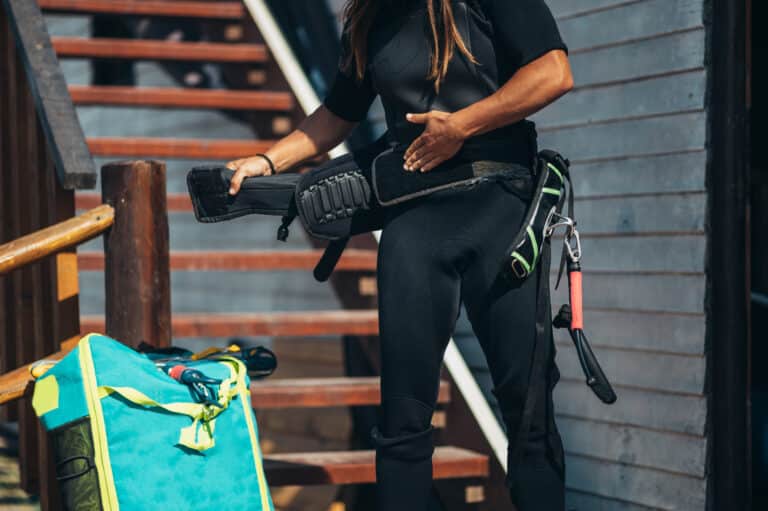What components does a kite bar have?
Kitelines
Kite lines can be divided into two main categories: Steering lines and front lines.
Steering lines (backlines): These are connected to the rear corners of the kite and enable steering. Pulling on one side of the bar shortens the respective steering line, which steers the kite in the corresponding direction. Steering lines carry less load than front lines and are usually slightly thinner. They are also color-coded to avoid confusion and ensure correct attachment.
Front lines (power lines): These lines are attached to the front corners of the kite and carry the majority of the pulling force generated by the kite. The front lines are crucial for depowering, i.e. reducing the pull by adjusting the kite’s angle of attack to the wind. If the bar is pushed forward, the pull and power of the kite are reduced
Materials: Kite lines are made from special thermoplastics that are processed into extremely robust fibers. Dyneema and Spectra are particularly popular – high-density polyethylene lines that are braided to minimize stretching. They are optimized and protected from UV radiation through heat treatment and special coatings. Although Dyneema SK 99 is the top product, it is rarely used due to its high cost. Its advantage: it hardly absorbs any water and floats – ideal for kiteboarding. With a diameter of 1.5 to 2.5 mm, they can withstand loads of 180 kg. up to 300 kg.
Floater
Float Floaters are important components of a kite bar that are attached to the lines, usually near the connections to the steering lines. Their main function is to keep the bar and lines floating on the surface of the water if the kitesurfer lets go of the bar. This prevents the bar from sinking and becoming difficult to reach.
In addition, the floaters ensure that the lines do not get tangled up so easily by stabilizing the connection points of the lines and keeping them tidy. Some floaters are also designed to cover the knots that connect the lines to the bar, which reduces wear and tear on the lines and protects them from abrasion.
The floats therefore contribute to both the safety and service life of the kite equipment by keeping the bar and lines on the surface and protecting them from damage.
Grip area
Materials and design: The grip area of the bar should be made of non-slip material that provides a good grip even when wet. The design should be ergonomic to promote a natural hand position and take the strain off the wrists.
Ergonomics and grip: An ergonomically designed handle ensures better comfort and control
The depower range of a kite bar is the range in which the kitesurfer can regulate the pulling force of the kite by moving the bar forwards or backwards. This mechanism controls the kite’s angle of attack to the wind and therefore the amount of wind that is absorbed by the kite, resulting in either more or less pulling power.
Depower range
-
Push forward: When the bar is pushed away from the body, the kite’s angle of attack is reduced. Thisdepowers the kite, i.e. the pull is reduced and the kite develops less power. This is particularly useful for controlling the kite in strong winds or in tricky situations
-
Pull back: When the bar is pulled back towards the body, the angle of attack increases, which catches more wind and increases the power of the kite. This is used to achieve maximum pulling power and speed.
The depower range is defined by the adjuster (depower rope), which allows the kiter to trim the kite according to the situation. The depower range can be adjusted individually depending on the kitebar, and some models even allow adjustment while riding.
Security system
These three components work together to make it easier to control the kite and ensure safety at the same time.
Quickrelease: The quickrelease is the most important safety element of a kitebar. It is located directly above the chicken loop and allows the kitesurfer to almost completely depressurize the kite in an emergency. Triggering the quick release releases the tension on all but one of the lines, so that the kite blows in the wind like a flag and loses its traction. This mechanism can be activated quickly in an emergency by pushing the shaft away from the body.
The quick release should be checked before each session to ensure that it is working properly.
Chicken loop: The chicken loop is a loop at the lower end of the kite bar that connects the kiter to the bar. It is hooked into the harness hook and ensures that the kiter does not have to hold the entire pulling force of the kite via the arms. The chicken loop makes it possible to let go of the bar and still have the kite under control. For unhooked tricks, the chicken loop is unhooked to provide more freedom of movement and can be hooked back in after the trick.
Chickendick: The chickendick (also known as the “chickendick pin”) is a small pin that is attached to the chicken loop and ensures that the chicken loop stays in the harness and does not accidentally pop out. It helps to secure the connection between the kiter and the bar during the ride by keeping the chicken loop stable in the hook. This is particularly important for hooked tricks and jumps.
What different types are there?
Fixed kite bars
Features: Fixed Bars have a fixed length and width and provide constant control without the ability to adjust. They are simple in design and easy to use.
Application: These bars are ideal for kitesurfers who kitesurf in consistent conditions and do not require any changes. They are particularly suitable for beginners who prefer uncomplicated and stable control.
Adjustable kite bars
Features: Adjustable bars are characterized by their variable width, which can be adapted to different kite sizes and wind conditions. This is achieved by adjustable ends of the bar, which make it possible to change the width of the bar. Some models also offer the option of adjusting the position of the steering lines or the depower system.
Application: Adjustable bars are perfect for kitesurfers who frequently use different kites and need to adapt quickly to changing wind conditions. They offer the versatility required to achieve the best performance in different conditions.
4-line kite bar
Features: The 4-line bar is the standard for most modern kiteboarding equipment. It offers optimal control and allows fine-tuning of the pulling power through the depower system. They have four lines – two front lines (for pulling) and two back lines (for steering). These bars are used on most modern tube kites.
Application: This type of bar is the first choice for most kitesurfers, regardless of their experience level. It offers a good balance between control and flexibility.
5-line kite bar
Properties: Some kites, such as certain C-kites or special kites with more power and better depower, use a fifth line. This is used to support the kite when relaunching or to stabilize it in strong gusts of wind.
Application: This bar is ideal for advanced kitesurfers who want maximum control and safety, especially in extreme conditions or freestyle.
Clickable
Features: Click bars are an innovative type of kite bar that allows easy and quick adjustment of depower directly on the bar. These bars have a special mechanism that allows the rider to adjust the pull of the kite with a simple click. This function is particularly useful as it facilitates operation while riding.
Application: Click bars are suitable for kitesurfers who appreciate high flexibility and easy handling while riding. They are ideal for all levels of experience, but offer a particular advantage for advanced kitesurfers thanks to the quick adjustment options.
How does a kite bar work?
Basic function
The kite bar is the most important control instrument in kiteboarding. It connects the rider to the kite and enables precise control. By moving the bar, the rider can steer the kite, change its speed and direction of flight and adjust the pulling force. The bar is therefore not only crucial for performance, but also for the rider’s safety.
Security mechanisms
Depower system
The depower system is a central safety mechanism that allows the kiter to quickly reduce the pulling force of the kite. This is done by moving the bar along the lines, which changes the kite’s angle of attack.
Quick Release and Safety Leash
The quick release system allows the kiter to immediately separate the kite from the kite bar in an emergency. The Safety Leash ensures that the kite is not lost after the bar is released. These safety mechanisms are crucial for preventing accidents and maintaining control of the kite in critical situations.
How do I choose the "right" one?
Matching the kite
Compatibility with different kite models
It is essential that the bar is compatible with the kite. Not every bar fits every kite, so you should make sure that the one you choose is suitable for your kite model. Pay attention to the manufacturer’s recommendations and check that the line length and steering mechanisms match.
Influence on the performance of the kite
The right bar can have a significant influence on the performance of your kite. A well-tuned one improves the control and responsiveness of the kite, while an unsuitable one can impair performance. It is therefore important to choose one that fits your kite perfectly.
Matching the driver
Ergonomics and handle size
The bar should fit well in your hand and give you a comfortable feeling. The grip size and the material of the grip play an important role in this. An ergonomically designed grip minimizes fatigue and improves control.
Comfort and ease of use
A user-friendly bar makes kitesurfing much easier. Pay attention to details such as the hooking and unhooking mechanism of the chicken loop and the ease of use of the depower line. These should be intuitive and easy to handle.
Suitable for the area of application
Requirements in different disciplines (freestyle, wave, race)
The requirements vary depending on the discipline in which you kitesurf. Freestyle kitesurfers may need a different bar than wave or race kitesurfers. Make sure you choose one that is specifically designed for your preferred discipline.
Adaptability to changing conditions
The bar should be flexible enough to adapt to changing conditions. Adjustable bars are an advantage here, as they allow you to adjust the length and tension of the lines and thus optimize control of the kite.
Which width is suitable for me?

Common widths: Bars are available in a variety of widths to suit the different requirements of kitesurfers and kites. The common widths are typically in the following ranges:
- 40-45 cm: These narrower bars are often used for smaller kites and stronger winds. They offer more precise and controlled movements, which is particularly important in demanding conditions.
- 46-50 cm: These medium widths are universal and suit a wide range of kite sizes and wind conditions. They offer a good balance between control and reaction speed.
- 51-55 cm: Wider bars are particularly suitable for larger kites and lighter winds. They allow larger movements of the steering lines, which leads to a faster and more direct response of the kite.
Influence of the width on the steering behavior:
Wider bars: A wider kite bar allows you to turn the kite faster, which is particularly advantageous for larger kites in light winds. These bars offer a more direct steering feel and can help to control the kite better in light wind conditions.
Narrower bars: Narrower bars offer finer control and are ideal when riding in stronger winds or with smaller kites. They enable more precise movements and are less strenuous on the arms as they require less torque.
Adjustable widths:
Some modern kite bars offer the option of adjusting the width of the bar. These bars are particularly versatile and allow you to adapt the width to the current conditions or to different kites. This is particularly useful if you kitesurf with different kite sizes or need to adapt to different wind conditions.
How do I extend the service life of my kite bar?

Regular inspection
Inspection for Wear and Damage: Regular inspections are essential to detect wear and damage early.
Care for Lines and Materials: Maintain the lines and materials by rinsing them with fresh water after each use and protecting them from direct sunlight.
Cleaning and storage
Correct cleaning techniques: Clean the bar and its components regularly to remove dirt and salt deposits.
Storage to extend service life: Store the bar in a cool, dry place to prevent damage from moisture and UV radiation.
Further information
You can find great additional information at LakeUnited, where there is a detailed explanation on how to properly adjust a kite bar. Readers learn how to optimally adjust various components like the chicken loop, depower line, and more to improve their kite control and safety. The guide offers practical tips and specific adjustment methods for different systems and sizes. By adjusting the kite bar correctly, kitesurfers can maximize their performance and safety on the water.




